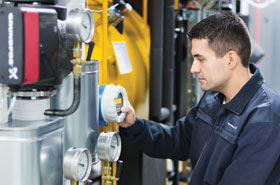

What does functional safety mean?
The term functional safety describes the capability of a system to maintain or accomplish the safe and controlled state of a plant – both under normal operating conditions and in the event of malfunctions. The aim is to avoid systematic errors, to identify and control accidental failures and to limit the risk of dangerous failures. The requirements involving the functional safety of electrical, electronic or programmable electronic systems are defined in the international standard IEC 61508, supplemented in IEC 61511 with rules for process applications.
What does SIL stand for?
SIL describes the Safety Integrity Level. Levels from SIL 1 (low) to 4 (high) specify how reliably safety functions must work in order to limit the risks to humans, the environment and assets to an acceptable level – at best to the unavoidable remaining risk. The defining factor is the likeliness of a dangerous event, its potential consequences – determined by extent and duration – and the options of hazard control.
Who is responsible for functional safety?
The plant operators are responsible. They must use a hazard and risk analysis to identify all dangers emanating from their plant – and so determine if and to what extent functional safety is required. To do so, they must look at the safety management, the qualification of their personnel and the technical requirements involving the safety system throughout its entire life cycle. Unlike the older standards, IEC 61511 demands quantitative proof from the operator.
How can the technical requirements be met in a plant or system?
Every safety system is made up of different components – normally control elements, actuators and sensors. The specifications for each device are defined by the architecture of the whole safety system. It is possible, for example, to accomplish SIL 3 by designing a safety-relevant measuring point with redundancy and equipping it with two identical SIL 2 instruments: if one of the devices fails, the other one continues to deliver a measuring value. Other options include the use of triple redundancies, or the use of two different measuring principles.
What does functional safety mean in terms of process measurement engineering?
To rule out systematic errors, IEC 61511 on principle allows two solution options: manufacturers must either develop devices according to the requirements of IEC 61508, or prove their proper function in use.
How does Endress+Hauser address the issue?
Endress+Hauser has, from a very early stage, seen the significance of functional safety. The outcome is a hitherto most extensive range of safety-oriented measuring instruments for process industries. 250 certified product lines for flow, level, pressure, temperature and liquid analysis are ready – all developed in compliance with IEC 61508, and many certified up to SIL 2 or 3.
Which features do these measurement instruments offer?
SIL-conforming measurement instruments feature continuous self-monitoring. The prescribed proof test can be started at the push of a button or with a software simulation without removing the sensor. Robust diagnosis and safety parameters extend the intervals between the proof tests. All this increases the availability of the plant and lowers operating cost.
Like all Endress+Hauser devices, the outstanding feature of SIL-certified instruments is their mechanical integrity, withstanding even the toughest process conditions such as strong vibrations, extreme pressures, high temperatures or aggressive media. Severe stress tests help to determine safe operating ranges. The device software is also stable and reliable. It is designed to avoid unidentified failures.
What time and effort does Endress+Hauser expend on this?
A good example is Liquiphant FailSafe. This level limit switch employs the tuning fork principle, having proven its reliability millions of times. But the device doesn’t use the usual relay, rather a subsystem based on two-wire technology. Even before a single unit had been sold, the Liquiphant FailSafe completed over 100 000 operating hours with 500 000 starts and 1,7 million switching operations. It was worth it: the devices are certified up to SIL 3. There is no need to install two probes; one device and therefore one process connection is sufficient – an advantage when it comes to demanding processes. The interval between the proof tests can be up to twelve years.
How else does Endress+Hauser support its customers?
Using the right kind of measurement engineering in the right application is also important in functional safety. Endress+Hauser has over six decades of experience in this field, with customers benefiting from that throughout the whole life cycle of their plant – from selecting the best measurement principle and optimum sizing of the device via the proper installation and start-up right through to maintenance, calibration, repair and replacement. With W@M Life Cycle Management, Endress+Hauser has a platform that supports the flow of information throughout the whole safety life cycle of the system with device-related data and documents. Finally, seminars and training sessions on this subject give all customers the chance to bring their knowledge up to date and to exchange experiences with other users.
For more information contact Hennie Blignaut, Endress+Hauser, +27 (0)11 262 8000, [email protected], www.za.endress.com
| Tel: | +27 11 262 8000 |
| Email: | [email protected] |
| www: | www.endress.com |
| Articles: | More information and articles about Endress+Hauser South Africa |

© Technews Publishing (Pty) Ltd | All Rights Reserved